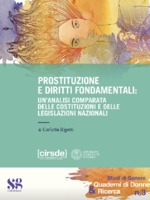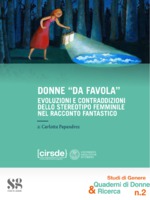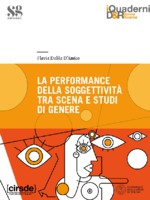Sfoglia documenti (13 in totale)
- Collezione: Studi di Genere. Quaderni di Donne & Ricerca
Sort by:
Prostituzione e diritti fondamentali: un'analisi comparata delle costituzioni e delle legislazioni nazionali
Lo scritto analizza i modelli legislativi esistenti in materia di prostituzione sul panorama europeo, soffermandosi su quei delicati profili giuridici inerenti il bilanciamento dei diritti fondamentali racchiusi nelle singole Costituzioni nazionali. In particolare l'analisi riguarda l'ordinamento russo, svedese, italiano e tedesco, che rispettivamente riflettono il proibizionismo, il neoproibizionismo, l'abolizionismo e la regolamentazione della prostituzione.
The work deals with the existing relationship between prostitute's fundamental rights and all the legal frameworks which are in force in Europe.
Chapter I examines some legal, thorny issues concerning prostitution, such as the disposal of the body, the notion of human dignity, the equality principle, the general clause of good customs, the right to work and to health and. In Chapters II-V these issues are transposed into the analysis of four European States' Constitution and legislations.
The Russian prohibitionism is characterised by the prostitutes' administrative prosecution on the basis of public morality and health.
The Swedish neo-prohibitionism aims at establishing a gender policy, which is grounded on a new social order; as a result, Swedish law subjects clients to sanctions, while considering prostitutes as victims who deserve a special protection.
Italian abolitionism provides for a freedom to prostitute yourself which must be in compliance with the general clause of public morality, while prosecuting all those activities that are ancillary and apt to violate the prostitutes' self-determination; in any case, the legislative aim is to respect and fulfil all the constitutional fundamental rights.
The German regulatory framework regards prostitution as an expression of the occupational freedom provided by the Basic Law, in order to promote the individual's substantial self-determination and to protect prostitutes' fundamental rights.
Finally the work ends with a short consideration on whether there is - or there is not - a legal pattern which is apt to protect all the fundamental rights to whom prostitutes are entitled.
Donne "da favola". Evoluzioni e contraddizioni dello stereotipo femminile nel racconto fantastico
How has the image of the woman changed over time? Can we say that certain "old" stereotypes have lapsed?
In this analysis I’ve reflected about the theme, comparing some modern cinematographic revisitations and the corresponding written texts in the field of the fantastic genre, to understand if and how the female image (and not only) has changed from a century to another (in this case between the 19th and the 21st century).
The research has developed through the semiotic and gender studies, in order to analyze the diversities and the characteristics of the various texts observed (written and audiovisual) and to realize how the idea of feminine is changed and, maybe, evolved, proposing new type of characters (and also a new and complex dialogue with the masculine counterpart).
It emerges, indeed, the necessity to reflect on these stereotypes, on the modalities of development over time and on the difficulty that still today, despite certain changes, remains in thinking them (and thinking differently).
Because, in the end, what does it mean male and female? What makes us who we are?
La performance della soggettività tra scena e studi di genere
My research focuses on the relation between the body and the subject in the field of performing arts (i.e. Dance and theatre). The goal of the research is on the one hand, to disclose how contemporary art practices rethink subjectivity by processing, comparing, and deconstructing its social images. On the other hand, to question the current methodological approach of the performing art theories.
Despite the Identity Studies (Disability Studies, Feminist Studies, Queer Studies ecc) and the artistic practices are questioning the categories of body, subject, genre and race, the theatrical scholars, at least in Europe, are far from the adoption of methodological and linguistic instruments suitable for the interpretation of the artistic and philosophical contemporary scenario.
The reformulation of the theatrical form took place trough decomposition of the whole of a genre into its individual elements. Text, body, lights, object, sounds are each treated as autonomous realities. Once the actor is free from the playing a character, the representation of the subject is entrusted to the body. Consequently, theatrical scholars, from different perspectives, have considered reduced the actor's ability to attest a subject. The main hypothesis of this research is that artistic practices go beyond both stereotypes and available scientific theories, creating further lens for the reading of subjectivity. At the same time these experiences put into question the adoption of uniform and stable categories for the interpretation of the actor's work.



